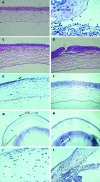Overexpression of IL-8 in the cornea induces ulcer formation in the SCID mouse
- PMID: 16418304
- PMCID: PMC1857070
- DOI: 10.1136/bjo.2005.084525
Overexpression of IL-8 in the cornea induces ulcer formation in the SCID mouse
Abstract
Aims: Although interleukin 8 (IL-8) is not produced in the normal cornea, it has been detected there in several pathological conditions. In this study, the direct effects of IL-8 overexpression on the cornea was examined.
Methods: The corneal surface of severe combined immunodeficiency mice was infected by the adenovirus vector encoding human IL-8 (IL-8/Ad5) and clinical and pathological changes were observed at various time points.
Results: Clinically, marked angiogenesis and ulcer formation in the cornea were observed by 12 hours and 24 hours, respectively. Histologically, prominent angiogenesis was observed in the corneal stroma at 12 hours. Cleft formation between the corneal epithelium and stroma, and neutrophil infiltration into the corneal stroma were seen at 16 hours. By 24 hours after the infection with IL-8/Ad5, a shallow ulcer was formed in the cornea. In contrast, infection with the control adenovirus carrying the beta galactosidase gene (LacZ) showed neither corneal ulceration nor neutrophil infiltration. Immunohistochemical analysis showed that infection with IL-8/Ad5 resulted in the production of IL-8 by corneal and conjunctival stromal cells.
Conclusion: Our results indicate that IL-8 overexpression in corneal tissue causes ulcer formation in the cornea through chemoattraction of neutrophils, suggesting the aetiological role of IL-8 in some types of corneal ulcers.
Similar articles
-
Adenovirus-mediated gene transfer to the ocular surface epithelium.Exp Eye Res. 1998 Nov;67(5):531-8. doi: 10.1006/exer.1998.0557. Exp Eye Res. 1998. PMID: 9878215
-
IL-17 receptor signaling influences virus-induced corneal inflammation.J Leukoc Biol. 2008 Feb;83(2):401-8. doi: 10.1189/jlb.0807571. Epub 2007 Nov 12. J Leukoc Biol. 2008. PMID: 17998300
-
Spantide I decreases type I cytokines, enhances IL-10, and reduces corneal perforation in susceptible mice after Pseudomonas aeruginosa infection.Invest Ophthalmol Vis Sci. 2007 Feb;48(2):797-807. doi: 10.1167/iovs.06-0882. Invest Ophthalmol Vis Sci. 2007. PMID: 17251480
-
Proteinases of the cornea and preocular tear film.Vet Ophthalmol. 2007 Jul-Aug;10(4):199-206. doi: 10.1111/j.1463-5224.2007.00546.x. Vet Ophthalmol. 2007. PMID: 17565550 Review.
-
Clinical application of nerve growth factor on human corneal ulcer.Arch Ital Biol. 2003 Mar;141(2-3):141-8. Arch Ital Biol. 2003. PMID: 12825325 Review.
Cited by
-
Innate and Adaptive Gene Single Nucleotide Polymorphisms Associated With Susceptibility of Severe Inflammatory Complications in Acanthamoeba Keratitis.Invest Ophthalmol Vis Sci. 2021 Mar 1;62(3):33. doi: 10.1167/iovs.62.3.33. Invest Ophthalmol Vis Sci. 2021. PMID: 33755043 Free PMC article.
-
Expression of Human Interleukin 8 in Mice Alters Their Natural Behaviors.J Inflamm Res. 2022 Apr 13;15:2413-2424. doi: 10.2147/JIR.S355669. eCollection 2022. J Inflamm Res. 2022. PMID: 35444450 Free PMC article.
-
Disparate Entry of Adenoviruses Dictates Differential Innate Immune Responses on the Ocular Surface.Microorganisms. 2019 Sep 13;7(9):351. doi: 10.3390/microorganisms7090351. Microorganisms. 2019. PMID: 31540200 Free PMC article. Review.
-
Functional Deficits in Mice Expressing Human Interleukin 8.Comp Med. 2020 Jun 1;70(3):205-215. doi: 10.30802/AALAS-CM-19-000049. Epub 2020 Apr 20. Comp Med. 2020. PMID: 32312361 Free PMC article.
-
Cigarette smoke extract and heated tobacco products promote ferritin cleavage and iron accumulation in human corneal epithelial cells.Sci Rep. 2021 Sep 17;11(1):18555. doi: 10.1038/s41598-021-97956-3. Sci Rep. 2021. PMID: 34535730 Free PMC article.
References
Publication types
MeSH terms
Substances
LinkOut - more resources
Full Text Sources
Other Literature Sources
Molecular Biology Databases



